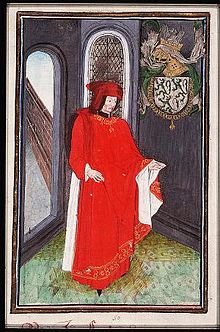
Jean II de Lannoy or Jan van Lannoy (1410–1493), lord of Lannoy, Lys and Sébourg, was a nobleman from the County of Hainaut who played a prominent role in the politics of the Burgundian Netherlands.
Life
Jean was a member of the noble de Lannoy family. He was the son of a Jean I de Lannoy who died in the Battle of Agincourt and of Jeanne de Croÿ, whose father, Jean I de Croÿ, also died at Agincourt.
As a young man, Lannoy had a military career, fighting against the Prince-Bishopric of Liège (1430), England (1436), Lorraine (1440) and the Electorate of Cologne (1447). In later life he wrote to his son that when called upon to speak in sessions of the council he could feel self-conscious about his lack of education.
In 1448 he was appointed by Philip the Good as stadtholder of the County of Holland and Zeeland, a function he held until 1462. He probably owed his appointment to his uncle, Antoine I de Croÿ. Between 1459 and 1463, he was also stadtholder of Walloon Flanders.
In 1451 he became a Knight in the Order of the Golden Fleece. In 1452–53 he participated in the suppression of the Revolt of Ghent (1449–1453).
He became an ally of the Dauphin, the future Louis XI of France, during his exile in the Burgundian domains (1456–1461), and helped him claim his throne in 1461. His closeness to the new king of France led to his deprivation from office in the Low Countries in 1462–1463, and in 1468 to open conflict with Duke Charles the Bold, who for a time forced him into exile.
In 1477 he served Maximilian I of Austria as Chamberlain and conducted several diplomatic missions. In 1478 he negotiated with cities of Tournai and Cambrai, episcopal lordships of the Holy Roman Empire then under French protection. He played a very important role in negotiating the Treaty of Arras (1482).
He died on 18 March 1493.
References
- Brown-Grant & Damen 2022, p. 265.
- Mario Damen, "Education or Connections? Learned officials in the Council of Holland and Zeeland in the fifteenth century", in Education and Learning in the Netherlands, 1400-1600: Essays in Honour of Hilde De Ridder-Symoens, edited by Koen Goudriaan, J. J. Van Moolenbroek and Ad Tervoort (Leiden and Boston, 2004), p. 54
- ^ Alphonse Wauters, "Lannoy (Jean de)", Biographie Nationale de Belgique, vol. 11 (Brussels, 1891), 325–329.
- Mario Damen, "The Nerve Centre of Political Networks? The Burgundian Court and the Integration of Holland and Zeeland into the Burgundian State, 1425–1477", in The Court as a Stage: England and the Low Countries in the Later Middle Ages, edited by Steven Gunn and Antheun Janse (Woodbridge, 2006), p. 73.
- Adrian Armstrong, "Alain Chartier and the Rhétoriqueurs", A Companion to Alain Chartier (c.1385-1430): Father of French Eloquence, edited by Daisy Delogu, Joan E. McRae and Emma Cayley (Leiden and Boston, 2015), p. 308.
Sources
- Brown-Grant, Rosalind; Damen, Mario, eds. (2022). A Chivalric Life: The Book of the Deeds of Messire Jacques de Lalaing. The Boydell Press.